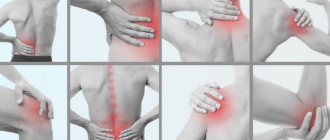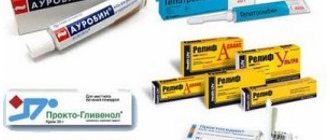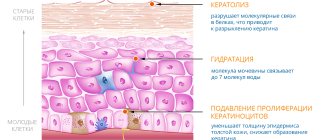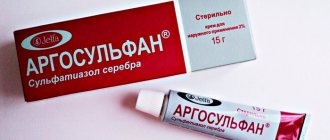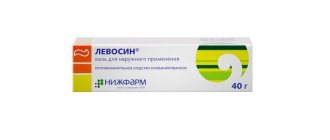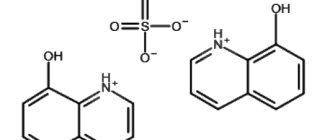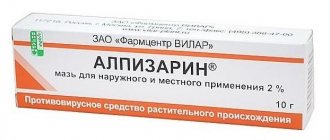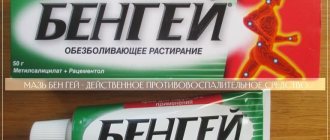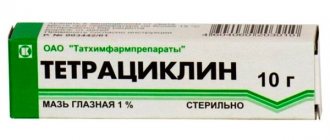Analogs
Level 4 ATC code matches: Dolobene
Nayatoks
Finalgon
Apizartron
Bee venom
Dimexide
Menthol oil
Alflutop
Gum turpentine
Capsicam
Tizol
Camphor alcohol
Turpentine ointment
Formic alcohol
Mataren Plus
Dimethyl sulfoxide
Fast Relief
Bishofite, Nicoflex, Rumalon and have a similar effect .
pharmachologic effect
After applying the ointment to the affected area, part of the active ingredients is absorbed, almost immediately causing the patient a slight burning sensation, redness or warming of the skin in the affected area. This is the result of stimulation of pain and cold receptors, in which the local irritating and distracting effect of the drug is manifested.
You can feel the maximum therapeutic effect of Gevkamen an hour and a half after application to the skin.
The oils and menthol included in the composition block substances that cause pain (neurotransmitters), dilate capillaries, reduce inflammation and swelling, and improve local blood flow. Racemic camphor has powerful anti-inflammatory, antiseptic and antibacterial properties.
As a result of improving microcirculatory processes, toxic substances are removed from the affected area, metabolism and tissue regeneration are accelerated, and their functions are restored.
Reviews about Gevkamen
This remedy is very popular, and is used by patients in a variety of cases when a “distracting” and analgesic effect is required. At the same time, reviews about Gavkamen are mostly positive.
Many patients note its good and quick effect, as well as its inexpensive cost. Other users are wondering what Gavkamen ointment helps best with and should it be kept in a home medicine cabinet for emergencies? Everyone who has used this product claims that the ointment is excellent when it comes to eliminating various pain syndromes. However, experts note that you should not abuse such drugs, since prolonged pain relief can only complicate the disorder.
Description of the drug
Gevkamen is a thick transparent ointment of white or slightly yellowish color. The drug has a sharp, specific smell of essential oils. It is quickly absorbed, providing a therapeutic effect immediately after contact with the skin.
After a few minutes, a feeling of cold occurs at the application sites. This helps to quickly reduce the severity of even intense pain. Then a pleasant feeling of warmth arises due to the rush of blood to the surface of the epidermis.
What is Gevkamen ointment used for in rheumatology, neurology, traumatology, orthopedics:
- damage to nerves, including intercostal nerves, accompanied by acute pain;
- joint pain characteristic of one or several joints at the same time (polyarthralgia);
- diseases accompanied by the development of an inflammatory process in skeletal muscles.
Gevkamen is used to eliminate pain during relapses and in remission. Using an ointment often helps avoid taking systemic analgesics or allows them to be reduced in dosage. In this way, doctors reduce the pharmacological load on the patient’s body and prevent side effects of drugs.
Clinical and pharmacological group
Gevkamen is a representative of the clinical and pharmacological group of external agents that have a local irritant effect. Ointment refers to drugs intended to eliminate local muscle or joint pain.
pharmachologic effect
The medicinal product contains ingredients of plant origin containing biologically active substances. Local application of Gevkamen leads to irritation of sensitive nerve endings located in the subcutaneous tissue.
As a result of this effect, blood vessels dilate. In turn, this causes improvement in tissue trophism:
- a large amount of nutrients begins to flow to the affected muscles and joint structures;
- the speed of metabolic processes increases;
- products of the inflammatory or degenerative-dystrophic process are removed from the tissues.
At the same time, pain impulses are suppressed due to the occurrence of a “distracting” effect. Essential oils have a weak anti-inflammatory, anti-edematous, regenerating effect.
Gevkamen ointment is often used as a local drug for prolonged chronic cough. After applying the gel, thick mucus in the respiratory tract is liquefied and then productively evacuated from the body.
When applying the drug to the soles or upper back, nasal congestion disappears and breathing becomes easier.
Release form and composition
Gevkamen is produced by Russian pharmaceutical factories. The ointment is packaged in 25, 30 or 40 g in aluminum tubes or dark glass bottles. Secondary packaging is cardboard boxes, which also contain instructions for use. In some cases, there is no secondary packaging, and the blurb is provided as an insert upon purchase. The active composition of Gevkamen ointment is represented by the following ingredients:
- levomenthol;
- racemic synthetic camphor;
- natural eucalyptus oil.
Manufacturers use medical petroleum jelly, paraffin and clove oil as auxiliary components.
Additional ingredients ensure the fastest transdermal absorption of camphor, levomenthol and eucalyptus oil.
Storage conditions and periods
According to the description given in the instructions, Gevkamen ointment contains ingredients that require special storage conditions. The optimal temperature is 5-15 °C. Freezing the medicine is unacceptable, as is exposing it to direct sunlight. Small children should not have access to the drug. If it gets on the mucous membranes, cutting, burning, and acute painful sensations may occur.
Gevkamen price, where to buy
You can buy Gevkamen in the form of an ointment for external use at a price of 35 rubles.
- Online pharmacies in RussiaRussia
- Online pharmacies in KazakhstanKazakhstan
Pharmacy Dialogue
- Gevkamen ointment (tube 25g) BZMP
39 rub. order - Gevkamen ointment (tube 25g) Tula FF
78 RUR order
- Gevkamen ointment (25g jar) Tula FF
66 RUR order
show more
Instructions for use
The instructions for use recommend using Gevkamen only in consultation with your doctor. If intense pain occurs, the use of ointment is not advisable. As prescribed by the doctor, the patient undergoes a full medical examination to determine the cause of the discomfort.
Gevkamen is included in therapeutic regimens when diagnosing aseptic
th inflammatory process. If an infectious lesion is detected, the use of additional medications is required.
Indications and contraindications
Indications for the use of Gevkamen include inflammatory and degenerative-dystrophic joint pathologies. The ointment is included in therapeutic regimens when diagnosing arthralgia caused by the following diseases:
- rheumatoid, gouty arthritis;
- aseptic tendinitis, tendovaginitis, epicondylitis;
- pinching of nerve roots due to osteochondrosis of any localization.
The drug is also recommended for use in patients with muscle pain of various etiologies. Gevkamen is used in traumatology to speed up recovery from bruises, sprains, ruptures of ligaments, muscles, and tendons.
Otolaryngologists and therapists sometimes prescribe a drug to transform a dry cough into its wet, productive form. This is relevant in the treatment of tonsillitis, laryngitis, bronchitis, bronchiolitis.
Gevkamen is not allowed to be used in the treatment of children under 12 years of age or if there is an individual intolerance to its ingredients. The ointment must not be applied to the skin if there are microtraumas on it - abrasions, burns, cuts. The drug is not prescribed to patients with dermatological pathologies, especially at the acute stage.
The decision to use an external agent during pregnancy and lactation is made by the doctor. He compares the benefits of the drug for the mother and the potential risk of its use for the child.
Directions for use and doses
Single and daily dosages of Gevkamen vary depending on the size of the areas of the body with painful sensations. The frequency of application of the drug is 2-3 times a day. To enhance the medicinal effect, the drug is rubbed into the area of the affected joint until completely absorbed by the epidermis. After using Gevkamen, you must wash your hands. This will prevent it from getting on the mucous membranes of the nose, eyes, mouth and causing a burning sensation.
After two weeks of use, a second consultation with a doctor is required. He decides whether to continue ointment therapy or discontinue it. If after 2-3 days of treatment the severity of pain decreases slightly, then you should consult a doctor to clarify the diagnosis.
Side effects and special instructions
Only external use of Gevkamen ointment is allowed. If it accidentally enters the body, neurological and (or) dyspeptic disorders may develop. You should rinse your stomach and go to a hospital for medical help.
Sometimes, after applying the drug to the skin, local side effects occur. The most characteristic of them are redness, swelling, swelling of the epidermis, allergic rash, itching. To minimize side effects, it is recommended to first apply the product to a small area of skin.
Pharmacology
The effect of the drug is determined by the content of essential oils, menthol and camphor.
The main substances that treat inflammation are eugenol and caryofinella contained in clove oil; cineole, α-pinene and p-cymene present in eucalyptus oil.
Terpene derivatives have an irritating effect. Evengol and eucalyptus oil substances reduce the effect of cyclooxygenase and lipoxygenase.
As a result of these processes, the reaction of the arachidonic cascade is blocked, the formation of substances such as prostaglandin, leukotriene, thromboxane at the site of inflammation is inhibited.
The ointment is used in the form of applications and as soon as it is applied, a noticeable burning sensation, swelling and increased temperature (hyperemia) appears at the site of the disease.
How ointment applications are applied is detailed in the video:
These manifestations arise both as a result of the activation of the action of the drug, and as a result of the appearance of serotonin, histamine and bradykinin under their influence. Under the influence of gevkamen, blood flow increases and regeneration processes increase.
Overdose and additional instructions
Not a single case of overdose was observed during treatment with Gevkamen.
This drug has low absorption. An overdose can occur if, by any chance, the drug is taken orally. In this case, heartburn, dizziness, vomiting and nausea are possible, in some cases a slow heart rate, weakness and convulsions.
It should be especially recalled that after application, hands are thoroughly washed with soap. The product does not affect the reactions of drivers and representatives of those professions where concentration is required.
There was no increase in the effects of alcohol when using the ointment, so those who like to “sip a glass” do not have to worry about this.
Since a certain amount of the drug enters the human body and passes through the liver and kidneys, we can say that the components of the ointment may have some effect on the functioning of these organs. But this amount is so small that it does not cause any pathologies.
If the drug is used for more than two weeks, then it is worth consulting with your doctor about the rationality of its further use.
Interactions with other drugs are negligible due to low absorption. But you should know that the ingredients included
Terpenes may reduce the effects of some medications due to their liver enzyme inducing properties.
When used together with non-steroidal drugs, Gevkamen enhances their effect in the area of penetration into the skin.
If there are indications for treatment for pregnant women and nursing mothers, then only if this medicine brings a positive result. It is best to consult a doctor.
special instructions
After applying the product, wash your hands thoroughly. It is necessary to avoid getting the medicine on the mucous membranes and eyes.
The drug "Gevkamen" does not affect the ability to drive a car. The ointment does not affect the speed of mental reactions and does not reduce concentration.
After the procedure, you must wash your hands thoroughly with soap to prevent accidental contact of the ointment with your eyes or mucous membranes of the body. If this cannot be avoided, the eyes and mucous membranes should be rinsed with plenty of water and, if necessary, consult a doctor.
The use of Gevkamen ointment does not affect the patient’s ability to drive vehicles and complex mechanisms.
Features of drug therapy for protrusions
Is Gevkamen ointment effective: what does it help with? The medicine can be used to treat the following pathologies:
- Tendinitis. In this condition, an inflammatory process occurs in the tendon tissues. A person often experiences burning pain in the area of the affected joint;
- Neuralgia. With this disease, peripheral nerves are damaged. The patient experiences sharp, paroxysmal pain;
- Arthralgia. With this pathology, persistent pain in the joint area is observed. Arthralgia may indicate organic damage to joint tissue. Most often, arthralgia affects large joints: shoulder, hip, knee or elbow. Much less often pain occurs in small joints: wrist or ankle. The main causes of arthralgia include: osteoarthritis, the presence of excess body weight in the patient, heavy metal poisoning, joint injuries, heavy physical work. Depending on the severity of pain, arthralgia is divided into weak, moderate and intense;
- Myositis. The pathology is characterized by the occurrence of an inflammatory process in the area of skeletal muscles. With myositis, painful sensations occur in the affected muscle. They intensify with movement and significant physical activity. The main causes of pathology are chronic infectious diseases and muscle strain.
Tendinitis Neuralgia Myositis Arthralgia
Gevkamen cream is an excellent remedy for dislocations and sprains. Therapeutic ointment eliminates the discomfort that occurs after insect bites.
The basis of treatment for disc protrusion in the lumbar sector of the spinal column is the use of pharmaceuticals. At the beginning of therapy, the effect is aimed at eliminating pain and reducing the activity of inflammation. Later, the patient is recommended pathogenetic treatment in order to relieve the complications that have appeared and to prevent relapses of the disease. The main task is the complete restoration of the functional functioning of the spine.
It is impossible to do without medicinal compounds for protrusion, because the patient is bothered by severe, debilitating pain, which cannot and should not be tolerated. The doctor prescribes analgesics to relieve discomfort, as well as anti-inflammatory medications. This allows you to remove swelling of the affected tissues, thereby eliminating compression of the nerve endings and, as a result, pain.
In particularly serious cases, when the pain syndrome is too severe, only paravertebral blockade of nerve endings can cope with it. To carry out this procedure, Novocaine and Lidocaine are used. In some cases, hormonal compounds are also used to help relieve inflammation - Dexamethasone, Prednisolone.
You should pay attention not only to the pain component of the disease, but also to the swelling. Swelling can be relieved with diuretics
Usually these are loop diuretics - Torasemide, Furosemide, but sometimes thiazide ones are also used - Cyclomethiazide, Hypothiazide. Since diuretics tend to remove potassium from the patient's body, its level must be replenished to prevent hypokalemia. For these purposes, it is recommended to eat potatoes, asparagus, parsley, dried apricots, currants and other foods rich in potassium.
Overdose
Due to the low systemic absorption of Gevkamen when administered topically, an overdose is unlikely.
Symptoms of overdose when the drug is ingested are nausea, vomiting, heartburn, dizziness, confusion, disorientation, low blood pressure, bradycardia, muscle weakness, miosis, convulsions.
Treatment: immediate gastric lavage. Since the typical clinical picture has not been established, careful monitoring of the patient's condition is required. To eliminate emerging disorders, supportive and symptomatic therapy is prescribed. There is no specific antidote.
Contraindications
Despite the naturalness of the ointment and the absence of chemical and synthetic components in its composition, it has some contraindications:
- skin diseases: eczema, dermatitis, psoriasis;
- wounds, scratches or cracks in the skin;
- children under 12 years of age;
- individual intolerance to the composition.
This remedy should be used with extreme caution by persons with a history of cardiovascular pathologies, severe liver and kidney disorders, and bronchial asthma.
Who is the ointment prescribed for?
- Deforming osteoarthritis with joint pain: a progressive joint disease with primary damage to cartilage tissue and subsequent dystrophic changes in the entire osteoarticular system, dysfunction, deformation and severe pain.
- Injuries of the musculoskeletal system (including sports).
- Ligament and tendon rupture or sprain: injury resulting from sudden (or excessive) movement in a joint.
- Bruise: damage to soft tissue after a blow or fall (no wounds).
- Myositis: inflammation of skeletal muscles with aching pain, muscle weakness and even muscle atrophy.
- Pain in joints and muscles due to sports overload.
- Neuralgia: diseases of the nerves with sharp acute pain in the innervated area.
- Headaches from overexertion.
- Cluster headaches: severe, paroxysmal, occurring at certain times of the day, often unilateral with clear localization.
- hypersensitivity to any of the components of the drug (intolerance to essential oils, their smell);
- impaired skin integrity: do not apply ointment to burn or wound surfaces of the skin, areas with manifestations of skin diseases, or scratching.
Features of interaction with other drugs
Due to low systemic adsorption, the drug interacts well with other medications. "Gevkamen" is allowed to be used in combination with anti-inflammatory non-steroidal medications intended for local use. The ointment helps enhance their therapeutic effects. The medication promotes rapid penetration of the active substances of non-steroidal drugs into the affected tissues.
Rubbing the ointment into the skin of the body is accompanied by a slight tingling, burning and/or feeling of cold.
Allergic reactions may develop during the use of Gevkamen.
It should be taken into account that the terpene components of the ointment are inducers of microsomal liver enzymes. In this regard, in the presence of concomitant therapy, the effect of other drugs may be weakened.
The simultaneous use of Gevkamen with local non-steroidal anti-inflammatory drugs increases the depth of their penetration into soft tissues and causes an increase in their therapeutic activity in the area of application.
When combined with ointment and dimethyl sulfoxide, the systemic absorption of the components of essential oils that are part of the drug is enhanced, and the depth of their penetration into the soft tissue in the application area increases.
